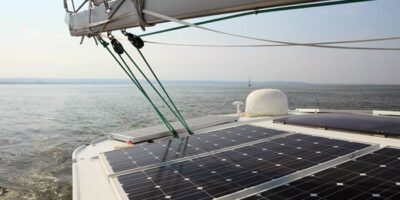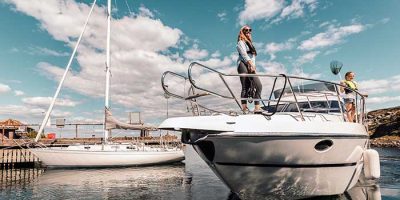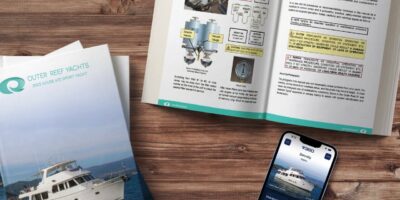Coping With Winter
Visiting your boat during the winter could save you a lot of headaches in the spring. Learn how to properly cope with wintertime.
- January 29, 2024
Claim #0918191: A BoatUS Member who keeps his boat at a marina in Galesville, Maryland, had always been conscientious about visiting his boat regularly over the winter, but a heart attack left him stranded at home under doctor’s orders to take it easy.
Take it easy? How could he relax when his boat was buried under record ice and snow? He called a boating friend and asked if he would take a look at his boat the next time he went to the marina. A good thing he did. During the time the member was recuperating, his boat’s cockpit scuppers had become blocked and water was spilling — trickling might be a better word — down the companionway hatch whenever the temperature climbed above 32 degrees. The companionway steps looked like a frozen waterfall and ice was well over the floorboards to the engine. His friend’s timely visit had averted much more serious damage.
Visiting your boat periodically is a must, especially in winter when freezing temperatures, snow, and ice can cause problems ranging from water stains on deck to burst hoses below the waterline. If you can’t visit your boat once or twice a month, consider using a “buddy system” with other boat owners to watch each other’s boats. A few minutes spent poking around your boat occasionally in winter can save you a lot of headaches next spring; it might even save your boat.
Where To Look
- If your boat’s in the water, the first thing to do is check the waterline. Is there a change? Check dock lines at the boat and on the dock for security and chafe. Adjust the chafe guards if necessary (heavy hose or commercially made chafe guards will keep your lines from shredding during bad weather). Make sure your fenders are placed properly and check for any marks on the hull that might signal a problem. Fenders that are tied to lifelines can wander — it’s best to have them more firmly attached to the boat. Smaller boats can be caught under a dock at low tide and then sunk when the tide rises; make sure dock lines are tight enough to keep them off the dock, but loose enough to allow for the variations in water level.
- Check cockpit scuppers and drains for blockage. Boats are sunk each year because leaves or snow prevented water from draining.
- If you have an inboard/outboard, examine the bellows (flexible rubber connections that seal the outdrive and cables from the boat). Look for cracks between the folds and check for a trail of water from the bellows to the bilge.
- Inspect your bilge. No good ever comes from water in the bilge and any standing water means a leak; even a small leak can eventually sink a boat. Check the operation of the bilge pump and float switch. If you’re not sure if your bilge pump is coming on while you’re away, consider installing a bilge pump cycle counter.
Pay special attention to your stuffing box; leaking stuffing boxes sink boats every year. A stuffing box should not drip at all when not in use. - Ensure that all through-hulls are closed (with the exception of cockpit drains) — many a cracked or slipped hose has sunk a boat. While you’re checking, it’s not a bad idea to open and close each seacock a couple of times to keep them from seizing.
Make sure your wheel or tiller is secured to prevent rudder damage from boat movement. - If you leave your shore power plugged in, inspect shore power cords beginning at the dock pedestal and follow to the inlet on your boat — look for places where the cord may have gotten pinched between the boat and dock, which can signify internal damage and cause the cord to overheat under load. Corrosion on the plug’s blades can cause heat and, if bad enough, a fire. Make sure the cord can’t get into the water or get crushed against the dock.
When The Boat Is Ashore
- If your boat’s stored ashore, check the jackstands, cradle, or trailer to make sure the boat hasn’t shifted. The boat should be level so that water drains properly and doesn’t cause stains or, worse, leaks down below. Verify that the stands are chained together under the boat with plywood under the jackstands to they won’t sink into the ground. If a jackstand has shifted, don’t try to adjust it yourself; contact marina personnel.
- Check scuppers and drains for blockage. Even boats stored ashore can “sink” when pooled water pours over the cockpit into the interior. If your boat’s on a trailer, make sure your hull drain plug is out so any water that finds its way below can drain.
- Examine your boat cover if you have one. Look for the beginning of tears, loose fittings, and chafe and make sure the wind hasn’t broken a tie-down line. Verify that covers aren’t allowing water to accumulate or inadvertently funneling water below — any cover that isn’t well supported will accumulate snow and water, which adds considerable weight to the boat. Covers should never be tied to jackstands and if you see one in the boatyard that is, contact the marina and let them know; strong winds can catch the cover and pull a jackstand out from the hull, sending the boat toppling. Tying water-filled one-gallon jugs to covers to keep them down is a good idea in places that are sheltered from wind, but is ineffective if the jugs leak and become lighter — and they can whip around and damage your boat. Don’t fill them all the way if your boat is in a frigid climate since expanding ice can crack them open.
- If you have a sailboat, a roller-furled jib creates significant windage and should be taken down when the boat is stored ashore. (Many marinas require that they be off the headstay.)
Outriggers stored at a 45-degree angle are prone to bending in ice storms. Outriggers should be disassembled or, if that’s not possible, stored vertically. - To prevent theft, check that all doors, companionways, and hatches are locked.
- When you step inside your boat, take a sniff. Does the boat smell moldy? There could be a portlight or hatch leak. Other smells, such as gasoline, propane, or vermin, need to be investigated right away. If you leave your 12-volt or AC electrical system on (the only things that should be on over winter are the bilge pump/high water alarm and smoke alarms along with a battery charger), sniff for any electrical odors. It’s possible that a circuit could be overloaded or shorted, or the battery is being overcharged — find the source.
- Check portlights and hatches for leaks and look for water stains. Sometimes water leaks appear at one place but begin at another — a leaking deck fitting can allow water to trickle into the bilge, so make sure that you fix what is really leaking. Better to take care of the problem now than have to delay your boating season with repairs next spring.
- Now is a good time to take sticky seacocks apart for servicing.
Engine Compartment
- Inspect battery terminals for corrosion and top off with distilled water (if you have conventional wet cells). If you have a multimeter, you can check the state of charge — 12.6 volts is typically fully charged but can be as high as 13.8 if attached to a charger. A bilge pump needs a fully charged battery to work properly, but keep in mind dead batteries don’t sink boats — they’re just a symptom of a larger problem. If you are plugged in to shore power, make sure your battery charger is the kind that turns off when the battery is fully charged so it won’t get overcharged. Most automotive chargers don’t work that way — and they’re not ignition protected, which means they could spark a fire from a fuel leak.
- Look for swollen or cracked hoses, rusted or broken hose clamps, and chafed or melted wires. Give wire and hose connections a tug — better to have them come apart now than while you’re not around. Don’t forget to check the fittings for your generator, if you have one.
- Look for any fuel, oil, or cooling-water leaks. You don’t want your bilge pump spewing oil into the water next spring or you could be in for a big fine.
BoatUS Editors
Contributor, BoatUS Magazine
About Vessel Vanguard
Vessel Vanguard is a leading marine safety and maintenance management software provider dedicated to revolutionizing the maritime industry. With a commitment to innovation and excellence, Vessel Vanguard delivers cutting-edge solutions to streamline operations and enhance vessel performance and safety.
Latest Industry Insights

Embracing E-Boating Efficiencies

Boat Fuel Systems

The Future of Boats & Boating

Yacht Navigation Light Inspection
View All of Our Industry Insights
Navigate maritime with the latest news, practical how-to guides, insightful analyses and more.
